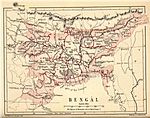Our website is made possible by displaying online advertisements to our visitors.
Please consider supporting us by disabling your ad blocker.
Partition of Bengal (1905)

| History of Bengal |
|---|
 |
| History of West Bengal |
|---|
 |
| History of Bangladesh |
|---|
 |
|
|
The first Partition of Bengal (1905) was a territorial reorganization of the Bengal Presidency implemented by the authorities of the British Raj. The reorganization separated the largely Muslim eastern areas from the largely Hindu western areas. Announced on 20 July 1905 by Lord Curzon, then Viceroy of India, and implemented West Bengal for Hindus and East Bengal for Muslims, it was undone a mere six years later.
The Partition was aimed at debilitating the Bengali and Indian nationalists, but in fact ended up only agitating them further, who perceived that it was a deliberate attempt to divide the Bengal Presidency on religious grounds, with a Muslim majority in the east and a Hindu majority in the west, thereby weakening the nationalist cause.[1] The Hindus of West Bengal complained that the division would make them a minority in a province that would incorporate the province of Bihar and Orissa. Hindus were outraged at this "divide and rule" policy,[2][3]: 248–249 even though Curzon stressed it would produce administrative efficiency. The partition animated the Muslims to form their own national organization along communal lines. To appease Bengali sentiment, Bengal was reunited by King George V in 1911, in response to the Swadeshi movement's riots in protest against the policy.
- ^ Chandra, Bipan (2009). History of Modern India. Delhi: Orient Blackswan Private Limited. pp. 248–249. ISBN 9788125036845.
- ^ Cite error: The named reference
EB Partitionwas invoked but never defined (see the help page). - ^ Cite error: The named reference
Chandra2009was invoked but never defined (see the help page).
Previous Page Next Page


